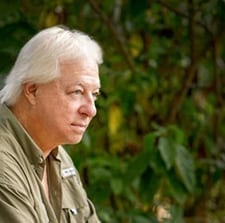See Rock City
October 20, 2017By Tom Poland
In Mom’s back yard stands a red and black birdhouse on a white pole. Its roof holds iconic words. “See Rock City.” If it had not been for Garnet Carter and Clark Byers, that birdhouse wouldn’t exist, for that birdhouse harkens back to a heralded part of Southern lore. Times were, you could drive along a back road and sooner or later you’d see a barn with its roof turned into an advertisement.
You’ll be hard pressed today to find a classic barn’s roof declaring “See 7 States from Rock City. Near Chattanooga Tenn.” In case you’ve never heard of it, Rock City is a roadside attraction on Lookout Mountain in Lookout Mountain, Georgia. Chattanooga is close by. Gigantic rock formations, gardens, a Lovers Leap, and caverns with black lights I recall. I remember, too, Ruby Falls but that is an attraction inside Lookout Mountain. (No one’s ever proved you can see seven states from Lookout Mountain.)

I saw Rock City as a boy but I can’t recall ever seeing a Rock City barn. Monday, October 16, I did. The barn you see here stands on Highway 28 between McCormick and Abbeville, South Carolina. All these years it was close by. Surely I must have seen it at some point. Just can’t recall it. I’m sure of one thing, though. Photographers and artists captured the old barn’s likeness. Weathered with boards missing and gaping holes here and there, the proud old barn stands as an art museum, a survivor.
A fellow by the name of Clark Byers climbed atop it. Byers’s barn-painting career started in 1935 when Rock City founder Garnet Carter turned some country barns into Rock City billboards of sorts. He found a receptive audience in depression-weary Americans who were ready to hit the roads and see the land. An ad on a barn’s rooftop had to be an eye-catching proposition.
All this barn roof-painting business came about as a way to market Carter’s public attraction. Rock City officially opened May 21, 1932. Soon after, Carter enlisted the help of a young sign painter from Trenton, Georgia. He hired Clark Byers to travel the nation’s highways and paint three simple words on barns: “See Rock City.” Byers, who looked a bit like James Dickey, painted the words freehand and the size of the barn determined the message. The bigger the barn, the longer the message. The distinctive black-and-white signs appeared as far north as Michigan and as far west as Texas. Rock City gave the farmers $3 or free passes to Rock City and in some cases Rock City thermometers and bathmats in exchange for turning their barn roofs into ads.
Before he turned to painting barns, Byers worked in a cotton mill and bottled buttermilk for $3 a week. He would go on to paint barns for three decades, dodging bulls, clinging to slippery roofs, and watching the horizon for thunderstorms. He retired in 1969 after nearly being electrocuted by a lightning bolt while repainting a barn. He had painted approximately 900 barns in nineteen states. Byers died in 2004. He was 89.
Weather and time and something nefarious robbed us of Byers’s work, although I hear a few successors to Clark Byers still paint barns. That’s fine but they aren’t the real deal. Many vintage Rock City barns suffered a needless fate thanks to the scourge known as politicians. If they’re not renaming lakes, putting their names on highways, and in general throwing history into the trash can, politicians find ways to destroy beauty in the name of bureaucracy. Today many reminders of days when families hit the road for family fun and togetherness are gone. Ladybird Johnson, you may recall, latched onto highway beautification as her First Lady claim to fame. During her highway beautification movement, roadside signs were deemed an eyesore. The “Ladybird Act” meant that many of Rock City’s rooftop messages had to be painted over.
As for Mom’s Rock City birdhouse, like many a Rock City barn, its best days are behind it. Neglect and decay make for formidable allies whether you’re an aged barn or a souvenir from Pigeon Forge, Tennessee.
I saw Rock City as a boy and now what seems 100 years later I can lay claim to seeing a Rock City barn. You can too. An online map of surviving Rock City barns directs you to these survivors (www.seerockcity.com). Georgia has five. South Carolina has one, and I saw it on Highway 28 four miles from Abbeville.
If I could turn back the hands of time, here’s what I would have liked to have seen eons ago. We’re on a family trip with Mom and Dad in an aqua-and-white 1956 Plymouth. Along Highway 28 we look to the left and see a new barn with a man on its roof. There’s Clark Byers sketching out his letters. Dad honks the horn and he turns and waves. He returns to work, using chalk to outline his message. “See 7 States from Rock City. Near Chattanooga Tenn.” We have no idea that we just witnessed history in the making but some sixty years later I would see what’s left of Clark Byers’s work, a ghostly, fading reminder of times past.
Visit Tom Poland’s website at www.tompoland.net
Email Tom about most anything. [email protected]
Tom Poland is the author of twelve books and more than 1,000 magazine features. A Southern writer, his work has appeared in magazines throughout the South. The University of South Carolina Press released his book, Georgialina, A Southland As We Knew It, in November 2015 and his and Robert Clark’s Reflections Of South Carolina, Vol. II in 2014. The History Press of Charleston published Classic Carolina Road Trips From Columbia in 2014. He writes a weekly column for newspapers in Georgia and South Carolina about the South, its people, traditions, lifestyle, and changing culture and speaks often to groups across South Carolina and Georgia, “Georgialina.”
Sign up here to start your free subscription to MidlandsLife!















